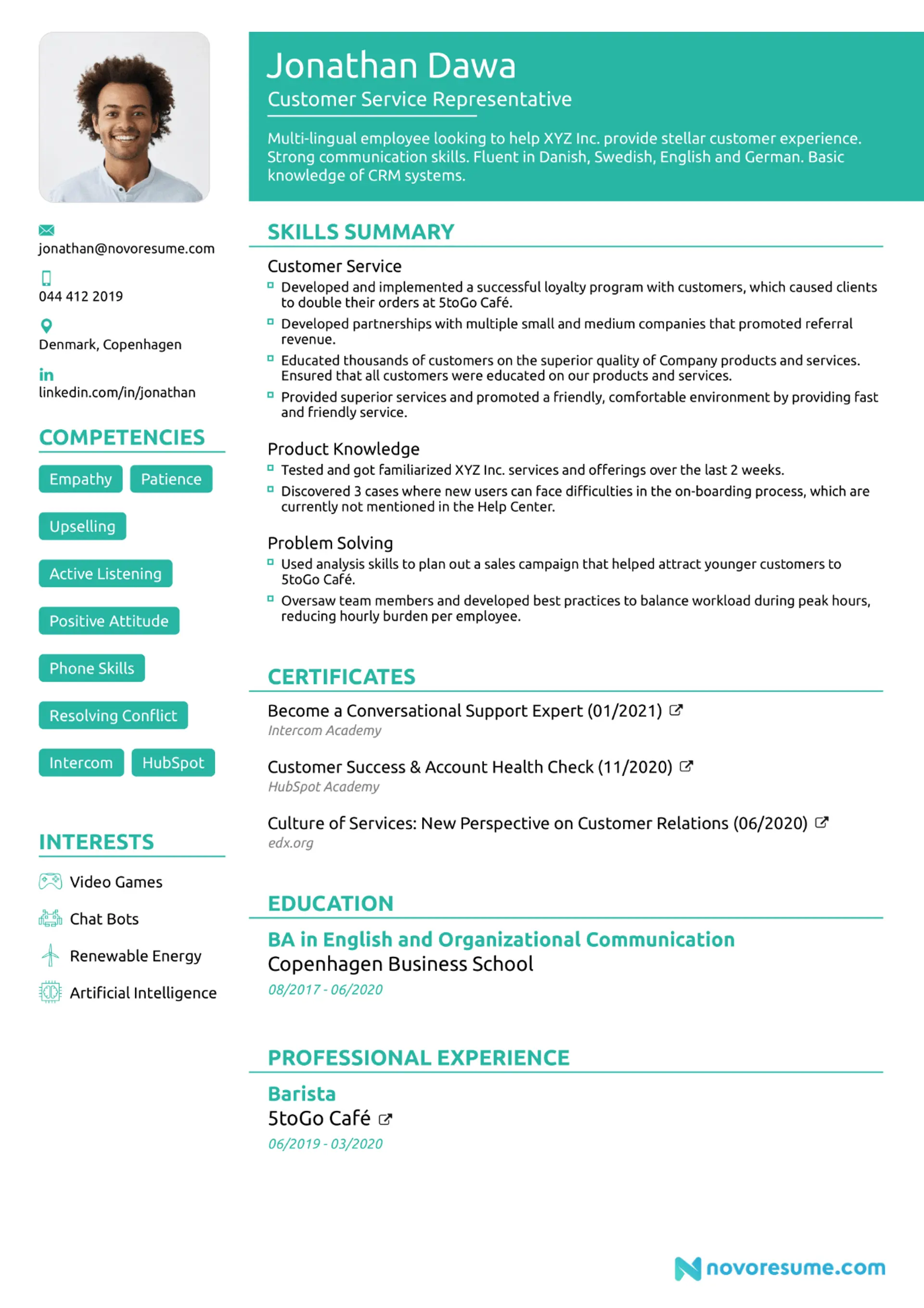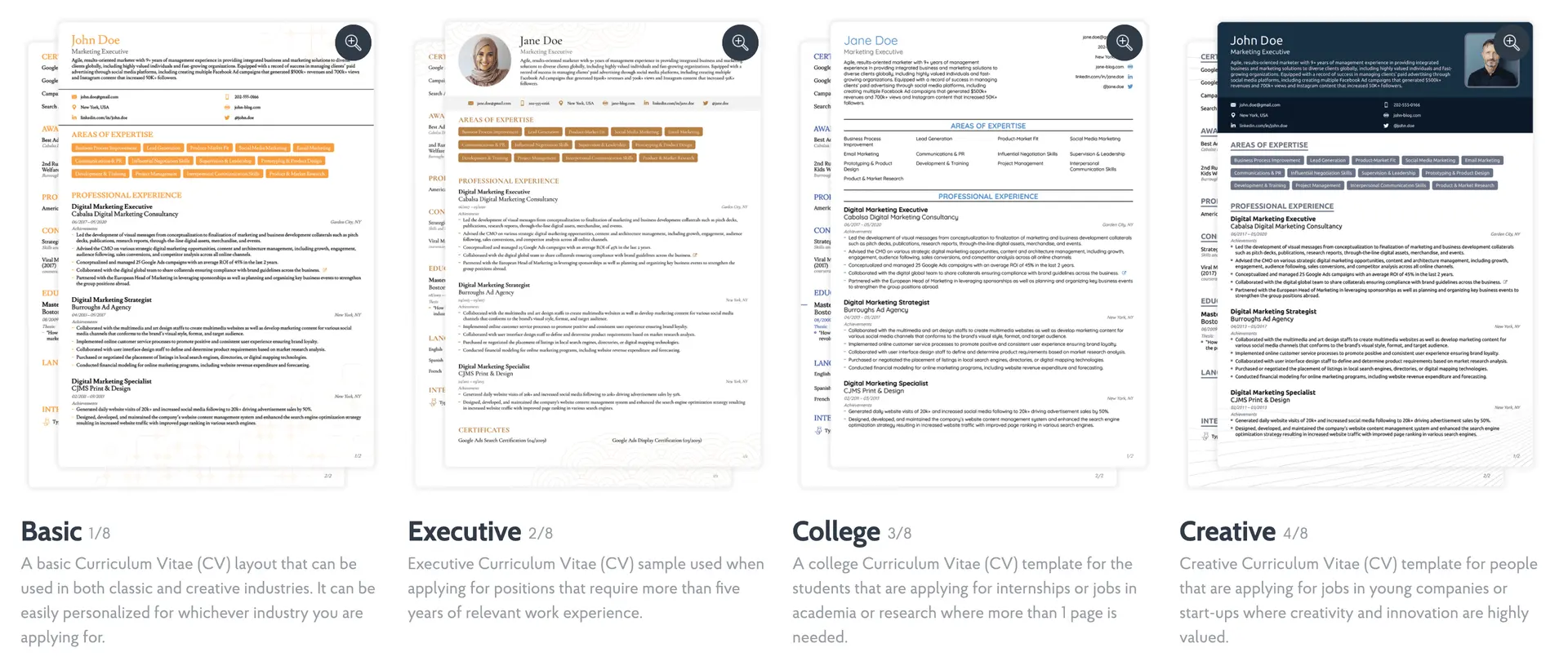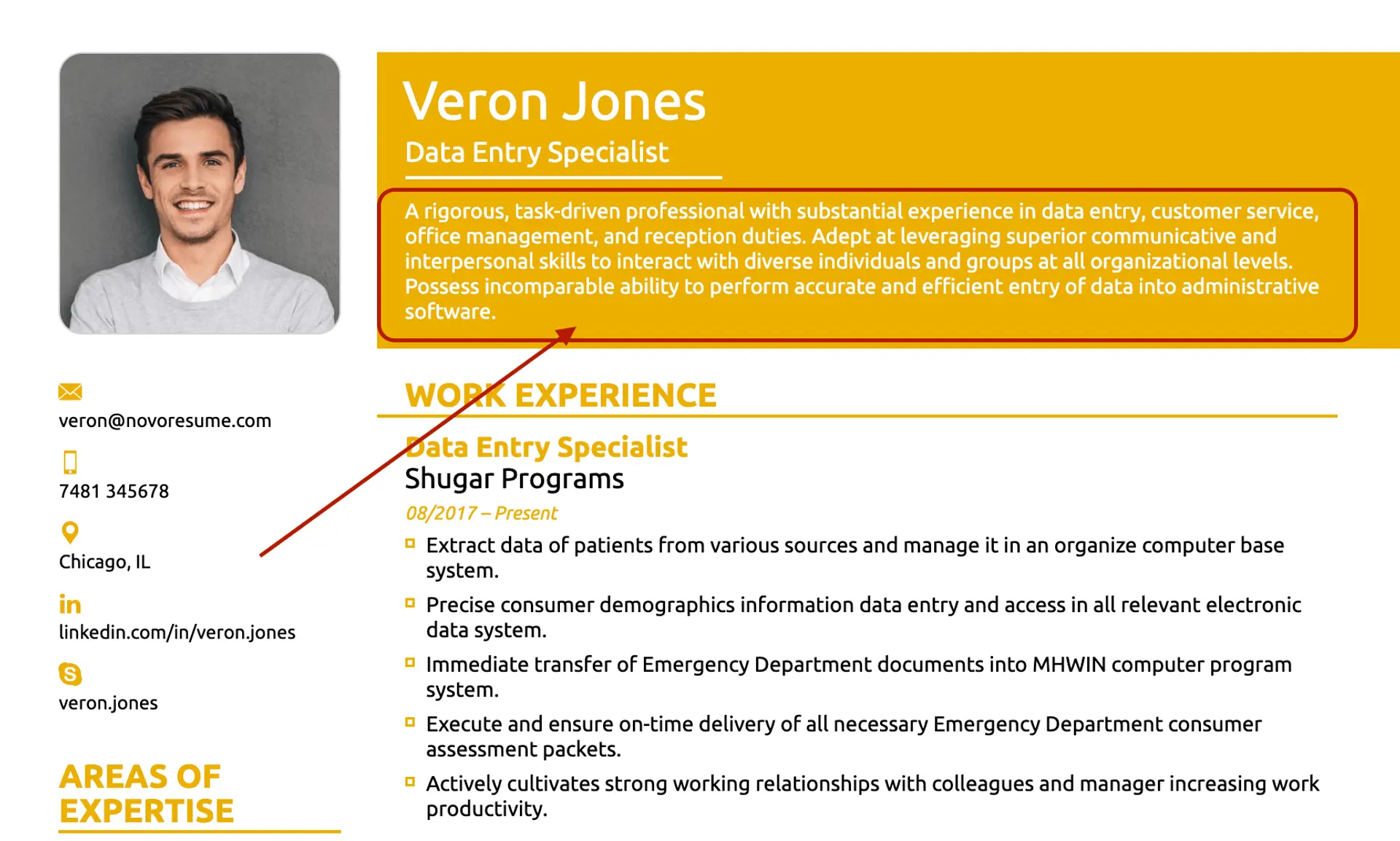What to Include in a CV [in 2026] | 11+ Essential Sections
Updated on 12/17/2025

The very first thing you need to do when making a CV is to decide which sections to include…
And that’s easier said than done - you probably have a ton of questions on what to include & where:
Should I put my education before or after work experience?
Do I include a hobbies & interests section, and will the hiring manager even care?
In this article, we’re going to answer all your questions on what to include in a CV!
Read on to learn about:
- What Sections to Include In Your CV
- How to Structure Your CV
- How to Format Your CV Contents
- 9 Things NOT To Include in Your CV
So, let’s get started.
What to Include in a CV
First thing’s first, the traditional CV should include the following sections:
In that exact order.
Once you’ve included these sections in your CV (and still didn’t manage to completely fill in your CV), you can also include some of the optional sections such as:
- Hobbies & Interests
- Languages
- Certifications
- Publications (If you’re a writer or academic)
- Training
- Awards
- Volunteering Experience
- Projects
- Extracurricular Activities
The optional sections are especially helpful if you’re a recent graduate with no work experience.
Sections like extracurricular activities or projects allow you to show that even though you don’t have practical work experience, you do have some experience working in a team and getting things done.
How to Structure Your CV
In most cases, you’d want to structure your CV as follows:
- Contact Information
- Resume Summary or Objective
- Work Experience
- Education
- Skills
- Optional Sections (If you have the space for it)
Or, to visualize this:

If you’re a recent graduate with no work experience, you’d put education on top of work experience (or eliminate work experience entirely):
- Contact Information
- Resume Summary or Objective
- Education
- Skills
- (Optional) Work Experience
- (Optional Extracurricular Activities
- (Optional) Projects
- (Optional) Volunteering Experience

Finally, if you’re making a career change CV, you’d organize your CV as follows:
- Contact Information
- Resume Summary or Objective
- Skill Summary
- Work Experience
- Skills
- Optional Sections

To learn how to create a skill summary, check out our combination resume guide.
What to Include in A CV - FAQ
Still have some questions on what to include in your CV? We’ll answer them here!

How to Format Your CV Contents
Now that we’ve covered all the essentials about what to include in your CV (and how to structure it), let’s talk about CV contents.
In this section, we’ll teach you how to format your CV entries for all the sections we just covered, starting with:
#1. Contact Information
The contact information section goes on top of your CV:
And includes the following information:
- Full Name
- Job Title
- Email Address
- Location. Just the city - don’t include an exact address.
- Phone Number
- (Optional) Social Media Profiles (LinkedIn, Behance, GitHub)
- (Optional) Personal Website
We recommend not including a photo in the US, UK, and Ireland, as that can lead to discrimination, but for other countries, you can check the following guide.
Make sure to use a professional email address, something like [Name] + [Last Name] @gmail.com. E.g.
Don’t use a work email address - that’s just disrespectful for your current employer.
And finally, only include social media profiles that are relevant. E.g. include your Twitter if you’re a social media manager (and how you manage your personal Twitter is a direct indicator of how good you are at your job).
#2. CV Summary or CV Objective
The CV summary or objective sits on top of your CV, right under your contact information:

Both CV summary and objective act as an introduction to your CV, and it’s usually the first thing that a recruiter reads. If the summary/objective is relevant for the role, they’ll read the rest of your resume. Otherwise, they’ll just stop here.
Here’s how the two (summary and objective) differ:
CV Summary - 3-4 sentence summary of your work history. A well-written CV summary includes:
[Professional Title] + [Years of Experience] + [Top 1-2 Achievements] + [Most Relevant Skill(s)]
For Example:
CV Summary
- Project manager with 10+ years of experience using agile and waterfall methodologies to take projects from start to finish. Managed over 3 separate IT projects from start to finish at last position at Company X. Basic knowledge of several programming languages, including React, C++, NodeJS, and Java.
CV Objective - This one’s pretty much the same thing as a CV summary, but with a focus on your goals and educational background instead of work history.
Usually, CV objectives are used by university students (with no work experience) or career changes (no experience in the field).
If you have work experience, though, you’re much better off using a CV summary.
In a CV objective, you mention:
[Your Current Situation] + [Desired Role] + [Relevant Educational Background] + [Relevant Skills]
CV Objective:
- Recent Communications graduate seeking to start my career with the role of secretary at XYZ Inc. Strong at time-management, writing, and multitasking. Some management and coordination experience through practical university projects, where I led a team of students to organize several events on university campus.

#3. Work Experience
The next thing on your CV is the Work Experience section.
Format this section as follows:
- Position Name
- Company Name
- Dates
- Location
- Responsibility & Achievement Bullets (6-8 bullets tops)
When possible, try to stick with achievements over responsibilities, as they allow you to stand out from the competition.
Good Example:
- Hit and exceeded department KPIs by 20% for the year 2019.
Bad Example:
- Managed sales at Company X.
The first example shows that you didn’t just work the job - you excelled at it. The second, however, just means that you did sales (just like all the other applicants for the job).
In addition, use data and metrics to backup your achievements.
If you say that you increased company sales by 20%, the recruiter knows you’re a high-achiever.
If you say you just “increased sales,” though, they don't know whether the number is 0.5% or 20%.
Work Experience Section Example:
Marketing ManagerNovorésumé09/2019 - Present- Managed a Google Ads advertising budget of over $15,000 per month, achieving a ROI of 62%.
- Created high-quality content on the topics of careers & resumes.
- Conducted partner outreach, sending out 200+ emails, and onboarding 32 partner companies.
- Created web copy for 5+ landing pages, managing to increase conversions site-wide by 1.2%.
#4. Education
Format your Education section as follows:
- Type of Degree & Name
- University Name
- Dates
Optionally, you can also include information like:
- Your GPA (as long as something impressive)
- Honors
- Top Academic Achievements
- Courses Taken
However, we only recommend doing this if your academic achievements are very important for the position you’re applying for (or if you don’t have much work experience).
Education Section Example:
B.A. in Computer ScienceUniversity of Copenhagen2016 - 2020GPA: 3.9/4.0Courses Taken:- Discrete Structures
- Cybersecurity
- Computer Forensics 101
#5. Skills
Listing your Skills section on your CV is relatively straightforward - all you have to do is list your top skills, and give them a proficiency level.
For example:

Here are some of our top tips on how to get your Skills section right:
- Make sure to mention the skills listed in the job description.
- Be realistic about your skill level. If you exaggerate a specific skill-set and get hired, you’ll eventually find yourself in very awkward situations.
- Focus more on hard skills than soft skills. After all, soft skills aren’t something you can show with your CV. Recruiters usually look for hard skills on the CV to make sure you’re a good skill-fit, and then analyze your soft skills during the interview.
#6. Optional Sections
Here’s how you can format the optional sections on your CV:
- Hobbies & Interests. Just list out your hobbies.
- Languages. List the languages you know with the appropriate skill level (e.g. beginner, intermediate, etc.).
- Certifications. Mention the name of the certification, optionally the institute you received it from, and the date.
- Publications (If you’re a writer or academic). Include the name of your article, the publication name, and a link.
- Training. Mention the training provider, program name, and a description.
- Awards. Mention the name of the award and the date you received it.
- Volunteering Experience, Projects, and Extracurricular Activities. For these items, just format them like you would format your work experience.
Need more guidance? Head over to our step-by-step guide on how to write a CV!
8 Things Not To Include In Your CV
Now that we’ve covered all the DOs of CV-making, let’s talk about the DON’Ts. Here are the things you should NOT include in your CV:
- Exact address. While popular back in the day, you don’t need to include your address in your CV. The recruiter is not going to pop by for a quick coffee.
- Date of Birth. It might lead to discrimination based on age.
- Irrelevant Social Media Profiles. E.g. If you're applying for a job as an accountant, you don’t need to mention your Behance profile (a social media website for graphic designers).
- Short-Term Jobs. If you’ve worked at the company for less than 1-2 months for whatever reason, don’t include it (unless it’s a temporary position). Even if you had a good reason for quitting the job early, it might look like you got fired or you’re a job hopper.
- Irrelevant Skills or Experiences. Only applying for the role of a software engineer, you shouldn’t talk about how much of a cooking pro you are. Only mention skills and experiences that allow you to excel at the job you’re applying for.
- Fluff. “I’m a great critical thinker,” “I have good teamwork skills,” “I’m super organized…” what do these 3 sentences have in common? It’s simple: none of them actually say anything useful. In your CV, only mention the skills or experiences you can back up with examples, otherwise, it won’t count.
- Images, Graphs, or Pie Charts. Avoid turning your resume into an infographic. Applicant tracking systems can’t read images and will automatically discard your CV.
- Too Much Work History. The recruiter doesn’t need to know what you did 25 years ago. With your work experience section, list only the last 10 years of work history.
Key Takeaways
Now, let’s do a quick recap of the most important things we’ve mentioned in this article.
In your CV, make sure to include:
- The essentials. This includes contact information, resume summary or objective, work experience, education, and skills.
- The optional sections, including extracurricular activities, projects, awards, training, certifications, hobbies and interests, volunteering experience, and others.
- Relevant information. Only mention the skills and experiences that allow you to excel at the job you’re applying for.
- Numbers and metrics. By backing up your experiences with data, you’re more likely to stand out from your competition.
